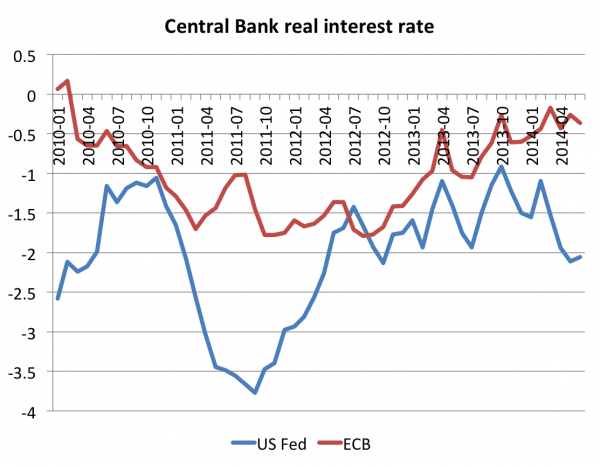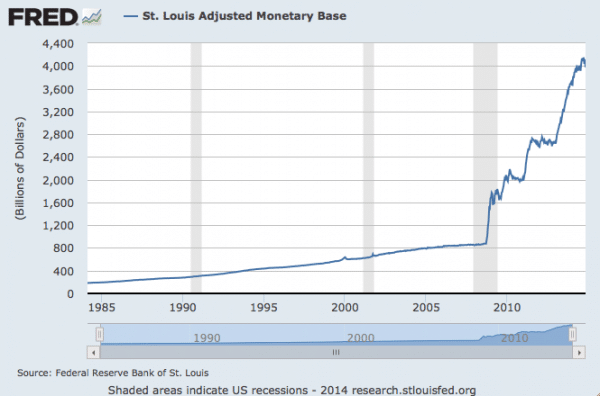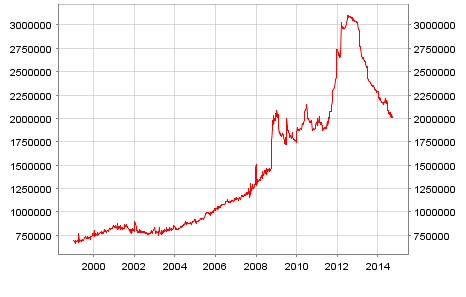Tight monetary policy implies the Central Bank is trying to reduce the demand for money and limit the pace of economic expansion.
A tightening of monetary policy, could involve an increase in interest rates. – Higher interest rates increase the cost of borrowing and discourage investment and consumer spending. A tightening of monetary policy would be appropriate in a period of positive economic growth and rising inflation, above the inflation target.
Europe has neither. The Eurozone is facing an inflation rate of 0.4% and weak economic growth. However, monetary policy has been relatively tight.
Two graphs from Antonio Fatas help to illustrate this.
Real interest rates in US and EU

Real interest rates are the nominal interest rate – inflation rate.
Therefore, with base rates of 0.5% and inflation of 4%, the US would have a real interest rate of -3.5% – This negative interest rates, in theory, should be more encouraging for people to spend rather than save.
By contrast, the ECB have had higher real interest rates. This is partly because they increased nominal interest rates in 2013, but mainly because European inflation has been lower. The decline in Eurozone inflation to 0.4% has had the effect of increasing real interest rates.
UK real interest rates have been similar to the US. UK inflation has been higher than Eurozone inflation.
The increase in real interest rates in Europe are a serious cause for concern and a good illustration of one of the problems of deflation / low inflation.
With deflation, monetary policy can become unsuitable. Because you can’t cut base rates below zero, monetary policy can become tighter than market conditions allow.
Unfortunately the higher real interest rates and the tightening of monetary policy makes deflation more likely. It is a vicious circle.
Quantitative easing
Another issue is that the UK and US have both adopted quantitative easing – increasing the monetary base of the Central bank as they try and inject money into the financial system. In UK and US, the Central Bank has created money and bought government bonds.

St Louis adjusted monetary base
Balance sheet of ECB

Source: A.Fatas Q.E or Q.T?
In 2013, the ECB made commercial loans available. In 2013, firms took them out. But, by 2014 the loans are being returned. Basically, there was a temporary increase in liquidity, but now banks are returning this liquidity to the ECB, so there has been no improvement in the money supply.
The Q.E. of the ECB (if we can call it Q.E.) is very timid and relies on the demand for loans being made available. So far, the ECB have been unwilling to create money and purchase government bonds.
See also: Vox for comparisons between US Q.E. and ECB Q.E
In addition to monetary policy, fiscal policy has been tight in Europe due to the pursuit of austerity. The fiscal austerity means that Europe needs a looser monetary policy, but will it get one?
Related

A great insight into the workings of real interest rates. Mario Draghi has been looking to stimulate the Eurozone and should take a look at this blog!
Hope you don’t mind but I linked one of your posts as a reference on my blog. Keep up the good work!
Nice blog post, I really liked it. Discussing some monetary policies of Europe.